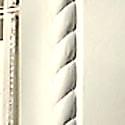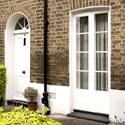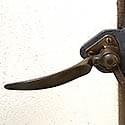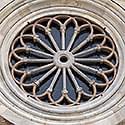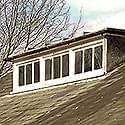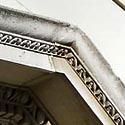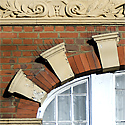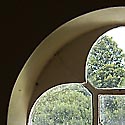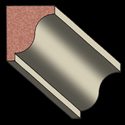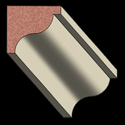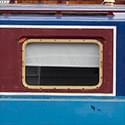
cabin–window (1), a port–hole or window in the hull of a canel/river–going or sea–going vessel, or in the fuselage of a passenger airplane.
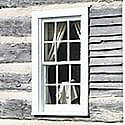
cabin–window (2), a window in a log–cabin, hut, or shed.
Illustrated here is the Kentucky Lincoln Farm log cabin in which in 1809 the 16th U.S. President, Abraham Lincoln, was born. Sash windows in a log cabin in the middle of Kentucky? The contrast between the primitive building method and the sophistication of the sliding sash seems too great to be credible, even though we know that sashes were in use in Boston a hundred years earlier. We also know of the local legend that the cabin was demolished and used in the construction of a nearby house. And that a New York businessman bought the Lincoln Farm, using logs from the house, replicated the cabin, which was then dismantled and exhibited in many cities. Photographs taken before demolition of the remains of the original cabin show tiny square windows. A description of the building in 1822 of a similar cabin give a clue to the likely nature of Lincoln’s windows — ‘In building our cabin it was set north and south . . . we had no idea of living in a house that did not stand square with the earth itself. This showed our ignorance of the comforts and conveniences of a pioneer life . . . We had a window, if it could be called a window, when, perhaps, it was the largest spot in the top, bottom, or sides of the cabin at which the wind could not enter. It was made by sawing out a log, and placing sticks across; and then, by pasting an old newspaper over the hole, and applying some hog’s lard, we had a kind of glazing which shed a most beautiful and mellow light across the cabin when the sun shone on it. All other light entered at the doors, cracks, and chimney’.
Photo: Unaltered image by Daniel Schwen reproduced under Wikipedia Creative Commons.
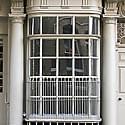
cabinet window, a projecting shop window, usually with rounded corners, first appearing in the early eighteenth century [Italian: gabinetto, a closet or press].
Caernarfon arch, see Welsh arch.
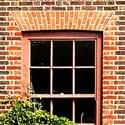
camber, a very slight upward curve in the soffit of a flat arch — in reality a segmental arch of very large radius.
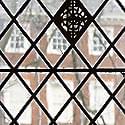
came, a small bar of cast or extruded lead of H–section, used for framing the glass in leaded lights [related to CALM, CAUM, CAULM, meaning a mould in which metal objects are cast (Oxford English Dictionary); other sources suggest Latin: calamus, a reed].
In these casements, located in a dairy, two of the glass quarries have been replaced by lozenges of pierced lead with a view to providing a degree of permanent ventilation.

canopy, a projecting roof over a balcony or a verandah, providing windows with shade and protection from weather [Latin: canopeum, hangings above a bed, mosquito curtains].
Does the most prevalent canopy shape, concave, reflect the original Latin meaning?
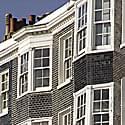
canted bay, a projecting ground–floor window with angled sides, which may rise through several storeys [Latin: campter, a turning, bending, or angle].
case and frame, a Scottish term occasionally used to indicate a box–sash; more frequently used is sash and case.

casement, usually a side–hung window, or pair of side–hung windows, opening inward in European Continental countries and outward in the UK and USA; the term can be applied to top– or bottom–hung, and to horizontal– or vertical–hung windows [Latin: casamentum, a small house or frame of a house].
Casements preceded sash–windows by many centuries but the distinction between the two is often unclear, as in this definition from Early American Architecture (Hugh Morrison, 1905) — ‘colonial windows were invariably of the casement or hinged type, the outward swinging sash being made of iron or thin wood bars’. This is a perfectly legitimate use of the word ‘sash’ as it simply means a frame, though it inevitably leads to confusion.
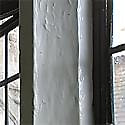
casement moulding, a wide concave moulding in a door or window jamb or arch.
The ecclesiastical or domestic late mediaeval equivalent of the Classical scotia.
casement–stay, a hinged metal arm for the purpose of holding open a casement window.
Early casement–stays held the window open in one position. Later stays were provided with holes that engaged in one or two metal pins, allowing the window to be held open at a number of predetermined positions.
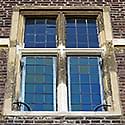
casement–window, generally used as an alternative to cross–window or mullion and transom window, but see also folding casements.
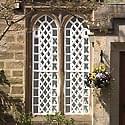
cast iron window, an alternative to wrought iron, cast iron windows may be in the form of fixed lights, casements, pivoting lights and, rarely, vertically sliding sashes — all generally containing subdivisions reflecting the traditional patterns and pane sizes of both timber and wrought iron windows.
Gradually improving techniques in iron–casting from the fifteenth century onwards led to the mass production of cast iron windows for a wide variety of applications, until finally being taken over by the mild steel window around the middle of the nineteenth century. The fire resistance of cast iron made these windows particularly suitable for use in factories and in buildings where the public habitually congregated.
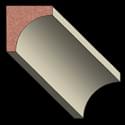
cavetto, a concave moulding, usually a quarter–circle, principally used in cornices [Latin: cavus, a hollow or cavity + –etto (Italian diminutive form)].
In the illustration can be seen a cavetto combined with a scotia, and a vertical external angle bead.
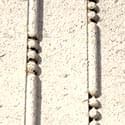
chaplet, a bead–like decoration, often found as a component of a window architrave, originally meaning a wreath for the head, or garland of leaves [French: chapeau, hat + et, diminutive form].
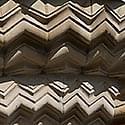
chevron, a v–shaped or zig–zag decorative moulding [French: chevron, rafter].
The term is derived from the repetition of pairs of inclined rafters.
Chicago window, an American version of the Wyatt window, in which the central double–hung sashes are replaced by a large fixed pane; the double–hung side sashes are retained. Named after the Carson, Pirie, Scott building in Chicago, 1899–1904, by Louis Sullivan.

cill, or sill, lower horizontal member of a window frame, or a masonry or other projection below the window frame, weathered to the outside in order to protect the wall below from rain [Latin: solea, the sole of a sandal].
The lowest horizontal member of a traditional timber structure is known as a sole–plate or sill–plate, which seems to suggest a connection, if only because of the custom in the building trade of adopting the nearest–sounding word. In earlier times the height of a window cill above floor level was greater than it is now, a minimum of 800mm or 2ft 7ins, as required by National Building Regulations. Balthazar Gerbier, in his Counsel and Advise to All Builders, 1663, refers to the leaning height of the cill, and says that this “ought to be three Foot and a half, since if otherwayes it will be incommodious, for being lower, it would require the bending of the back, which old men (when they have spent money and time in building) will not find so easy, as some wanton persons, who may be will affect low leanings, to make use either to sit on, and break the glasse–windows, or to shew themselves . . . to passengers”. According to Nicholson’s Practical Builder,1823, “the heights of sills are now reduced to two, or two feet six inches, or thereabouts”.
cinquefoil, having five sections or foils [French: cinque, five; feuille, leaf].
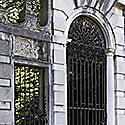
claire–voie, an opening formed in a hedge or a freestanding wall in order to frame a view without allowing access [French: claire, clear; voie, route].
The term, as used in France can mean a clerestorey window, a perforated screen, a balustrade — anything that lets light through. In English it is used mainly by landscape historians and designers with the more specific meaning quoted above — perhaps due to confusion over the word voie, to undiscriminating English ears very like vue, a view? The mistaken pronunciation ‘clairvoyee’ is sometimes heard and written. In the example shown the apparent ‘gates’ are permanently fixed into the openings in the stone structure.
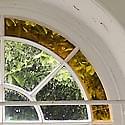
Claude Lorrain glass, yellow or straw–coloured glass, often used in the margin lights of early nineteenth century sashes.
A Claude Lorrain glass is a small smoked or tinted convex hand mirror used to reflect views, with the intention of emulating the effects seen in the paintings of Claude Lorrain (1605–1682), which often depict landscapes in warm late afternoon sunshine; but the name is also associated with yellow glass. In Nicholson’s New Practical Builder, 1823, we read: “plain coloured glass may frequently be used with very pleasing effect, and is little more expensive than good common glass. Coloured glass is charged by the pound; Claude Lorraine (sic), green, red, etc. at about six or seven shillings, and blue somewhat more”.
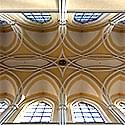
clerestorey, clearstorey, a term indicating the upper windows of the nave of a church, or high–level windows in domestic architecture.
The word is thought to be a combination of ‘clere’ meaning light, and ‘storey’ meaning an upper floor level of a building: the word, however, does not appear in that sense until the end of the sixteenth century, so what did earlier ages call the ecclesiastical version of these windows?
cockspur catch or fastener, a means of securing a casement window.
An arrangement in which a metal tail or handle, when hanging vertically, causes a flattened end at right angles to engage in a slot in the wooden frame of the window, holding the casement closed.
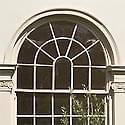
compass–headed window, a seventeenth century term describing a window in which the head is a complete semi–circle.
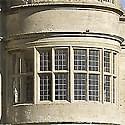
compass–window, a semi–circular bay window, as opposed to a bow window, the plan of which is normally understood to be based on a segment of a circle, set out using a pair of compasses.
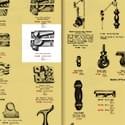
Comyn Ching, a name synonymous with architectural and builders’ ironmongery.
Few architectural practices throughout Great Britain could have managed without a copy of the ubiquitous Comyn Ching Catalogue (‘the Red Book’) before the advent of computers and the internet. Starting as a wholesale supplier to the building industry in the London area, the firm was founded in the first quarter of the eighteenth century (by a Mr Comyn and a Mr Ching, we assume). Their first establishment was in Shelton Street, London WC2, moving later to Golden Lane, EC1, with works established in Millwall and Oldham. From branches in Bristol, Sheffield, Bradford, and Ipswich they supplied the whole country with sash pulleys, cords and weights; No.3 sash chain with rustproof steel links and bronze rivets; spiral sash balances and adjustable spring tape sash balances; sash fasteners of all types; wedge stays and telescopic friction stays for casements; and a hundred other window–related products. The firm eventually succumbed to economic pressures and closed down, selling their Central London site to developers. The products are now sold by an ‘offshoot’ based in Bury St Edmunds, Suffolk, and can be found (in ‘Red Book’ format) on comynching.com.

console, a supporting scrolled bracket or corbel, plain or decorated [from the French consolider, to strengthen, reinforce ? (Oxford English Dictionary)]. See also ancon.
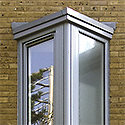
controlled–aspect window, usually a domestic window of a type restricting the view to one side or the other, in order to comply with national regulations restricting overlooking distance between properties.
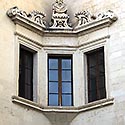
corner window, normally understood to mean a window with two faces, occurring at the external angle of a wall, but occasionally to be found located at an internal angle.
counterbalance–weight, iron or lead weights housed in a sash box forming the jambs of a vertically–sliding sash window, approximately equal in weight to the sash that they serve, but adjusted separately so as to ease the operation of both upper and lower sashes.
coupled Venetian windows, a pair of serliana windows overlapping and so sharing a narrow central light.
Or to put it another way: a tripartite window overlaps another tripartite window to form a cinquepartite window. It is possible to carry this process to extremes: see grouped serliana windows.

cremorne bolt, rotating rods with horizontal hooked terminations, operated by a knob mechanism and engaging in pins at the head and cill of a French window or similar. See also espagnolette bolt.
The Oxford English Dictionary tells us that cremorne is one of the many variations of the word ‘crumhorn’ [German; Krumhorn, a bent horn] a musical instrument of the woodwind family popular during the Renaissance period. Given the small diameter of the instrument and its hooked shape it seems highly likely that it gave its name to the similarly shaped bolt mechanism.
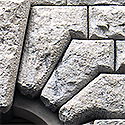
crossette, crosette, croisette, a joggled voussoir resting on an adjacent voussoir [French: crossette, diminution of crosse, crutch, crook].

cross–window, a window with one mullion and one transom.
Also known as a casement–window or mullion and transom window. The example shown is a blind cross–window.
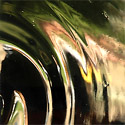
crown glass, a type of window glass, spun when molten in the form of a thin disc and subsequently cut into small panes of varying but limited size.
The view through, and reflections from, crown glass are subject to distortion from the centrifugal lines created during the manufacturing process. The weight to area ratio made it the glass of choice for the 120 years of the Georgian period due to the heavier excise duty imposed on thicker glass, thus creating the characteristic small–paned Georgian window.
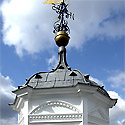
cupola, a small domed structure of circular or polygonal form, crowning a roof or larger dome, admitting light or air; a glazed lantern or skylight [Latin: cupella, a small tub or cask ].
The diplomat architect Balthazar Gerbier, writing in 1662, recommends that “a noble pair of stairs should have a Cupelo, and no Windows on the sides, which for the most part serve for Rude and Unadvised Men to break”; in other words ‘top lighting’.
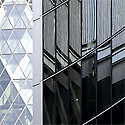
curtain–wall, derived from military architecture the term has come to mean, in modern buildings, a non–structural glazing system suspended from a framework of steel or concrete.



